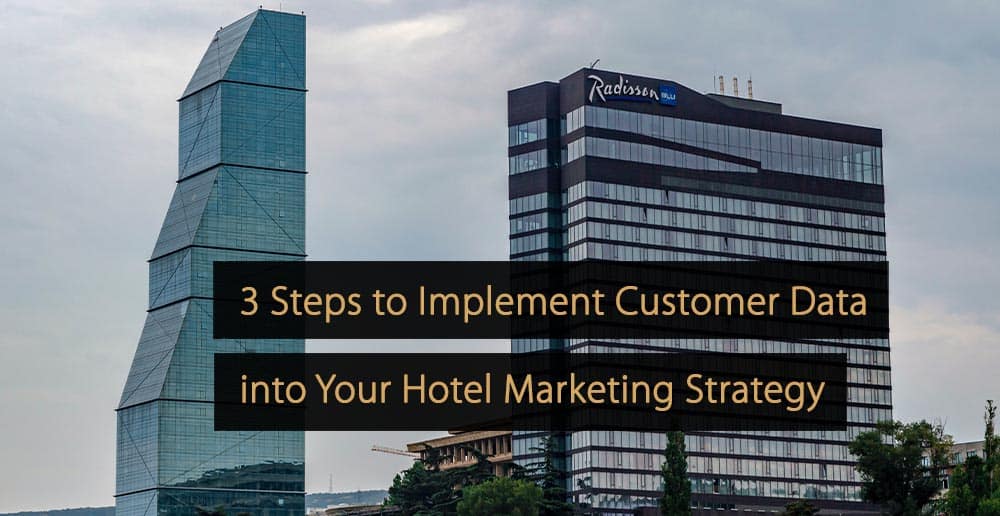Sich schnell an die Marktanforderungen anpassen zu können, ist eine Fähigkeit, die sich viele Hotelvermarkter unbedingt aneignen sollten. Und im digitalen Zeitalter kann es nie schaden, in Ihrer gesamten Geschäftsstrategie stärker auf Daten zu setzen. Eine Möglichkeit, dies zu erreichen, besteht darin, Kundendaten in Ihrem Marketing zu nutzen. Durch das Sammeln, Analysieren und Verwenden von Kundendaten kann Ihr Hotel seine Marketingmaßnahmen anpassen, um die gewünschte Zielgruppe effektiv anzusprechen und das Gesamterlebnis der Gäste zu verbessern.
3 entscheidende Schritte zur Implementierung von Kundendaten in die Hotelmarketingstrategie
Diese Erkenntnisse helfen Ihnen, fundiertere, datenbasierte Entscheidungen zu treffen und sind eine einfache Möglichkeit, Ihrem Team auf lange Sicht Zeit und Geld zu sparen. Und obwohl viele Hoteliers dazu neigen, die Macht der Kundendaten zu übersehen, ist es ein zuverlässiger Weg, sicherzustellen, dass Ihr Hotel der Konkurrenz immer einen Schritt voraus ist, wenn Sie sie zu einem Schwerpunkt Ihrer eigenen Strategie machen.
Schritt 1. Kundendaten erfassen
Das Sammeln von Kundendaten ist zu einem wesentlichen Aspekt für den Betrieb eines erfolgreichen Hotels geworden. Wenn Sie die Vorlieben, Verhaltensweisen und Bedürfnisse Ihrer Gäste verstehen, können Sie Ihre Dienstleistungen besser an ihre Anforderungen anpassen. Sie erhalten wertvolle Einblicke in die Verhaltensweisen und Vorlieben Ihrer Zielgruppe, indem Sie diese Informationen aus verschiedenen Quellen wie Direktbuchungen, Online-Bewertungen, Umfragen, Treueprogrammen, Webanalysen und Social-Media-Plattformen sammeln. Diese Datenkonsolidierung ermöglicht es Ihrem Team auch, umfassende Kundenprofile zu erstellen und Ihrem Unternehmen zu ermöglichen, personalisiertere Erlebnisse anzubieten.
Dies sind die wichtigsten Quellen, aus denen Sie Daten sammeln sollten:
Direktbuchungen
Direktbuchungen sind für Hotels eine wahre Goldgrube, da sie ihnen direkte Einblicke in die Vorlieben, Verhaltensweisen und Buchungsmuster der Kunden geben. Durch die Analyse dieser Daten können Sie beliebte Zimmertypen, bevorzugte Annehmlichkeiten und sogar die effektivsten Marketingkanäle identifizieren, um die Konversionsrate zu maximieren. Diese Informationen aus erster Hand ermöglichen es Ihnen, Angebote anzupassen und gezielte Werbeaktionen zu erstellen, um die allgemeine Zufriedenheit der Gäste zu steigern.
Online-Rezensionen
Online-Bewertungen haben in der Welt des Gastgewerbes eine starke Einflusskraft. Durch sorgfältiges Überwachen und Analysieren dieser Bewertungen können Sie die Erwartungen, Probleme und besonderen Interessen der Gäste besser verstehen. Indem Sie positives und negatives Feedback berücksichtigen, können Sie strategische Verbesserungen vornehmen, die bei Ihren Gästen Anklang finden. Zielgruppe und steigern Sie Ihren Ruf, während Sie neue Gäste gewinnen.
Umfragen
Umfragen sind für Hotels ein unverzichtbares Instrument, um direkt Feedback von Gästen zu sammeln. Einfallsreiche Hotels nutzen gut gestaltete Umfragen, um herauszufinden, was ihre Gäste vor, während und nach ihrem Aufenthalt erfreut, enttäuscht oder fasziniert. Dieses Feedback ermöglicht es Hotels, ihr Angebot zu optimieren, die Servicequalität zu verbessern und die Bedürfnisse der Gäste zu antizipieren, um wirklich personalisierte Erlebnisse zu bieten.
Treueprogramme
Treueprogramme sind ein hervorragender Kanal zur Datenerfassung. Sie ermöglichen es Ihnen, Gäste anhand von Reisemustern, Ausgabegewohnheiten und Vorlieben zu verfolgen und zu segmentieren. Durch die Analyse dieser Informationen können Sie maßgeschneiderte Vergünstigungen, Werbeaktionen und Prämien anbieten, um die Treue Ihrer Gäste zu stärken.
Netz Analyse
Durch Webanalysen können Hotels besser verstehen, wie Benutzer mit ihrer Website interagieren, welche pages beliebter sind und woher der meiste Verkehr kommt. Diese Informationen ermöglichen es Ihnen, datengesteuerte Entscheidungen zu treffen, um Verbessern Sie die Gesamtleistung Ihrer Website.
Social-Media-Plattformen
Sie können Stimmungen einschätzen, Einflussnehmer identifizieren und Einblicke in aufkommende Trends gewinnen, indem Sie Social-Media-Plattformen aktiv überwachen. Durch die direkte Interaktion mit Gästen auf diesen Plattformen können Sie umgehend auf Feedback reagieren, Hilfe anbieten und Beziehungen pflegen und gleichzeitig die Onlinepräsenz Ihrer Marke stärken.
Mit diesen Erkenntnissen können Sie personalisierte Erlebnisse gestalten, Bedürfnisse vorhersehen und Erwartungen übertreffen. Dies stärkt die Gästetreue und steigert den Umsatz, sodass Hotels in einer sich ständig weiterentwickelnden Branche langfristig erfolgreich sein können.
Wichtiger Hinweis zum Datenschutz
Obwohl das Sammeln von Daten Ihrem Hotel große Vorteile bringen kann, ist es wichtig, Zustimmung und Datenschutz zu priorisieren. Transparenz und Vertrauen sind beim Sammeln von Kundendaten von entscheidender Bedeutung. Daher sind das Einholen einer ausdrücklichen Zustimmung und eine klare Erläuterung des Zwecks der Datenerfassung wichtige Ausgangspunkte. Sie sollten Kunden auch die Möglichkeit geben, sich abzumelden, und ihre Entscheidung respektieren, falls sie dies wünschen.
Zu den Best Practices für den Umgang mit Kundendaten gehören die Beschränkung der Datenerfassung auf das Notwendige und Relevante, die regelmäßige Überprüfung und Aktualisierung der Datenschutzrichtlinien sowie die Durchführung interner Audits, um die Einhaltung der DSGVO und CCPA. Die Implementierung einer Richtlinie zur Datenaufbewahrung kann dabei helfen, Daten effektiv zu verwalten und Risiken zu minimieren, die mit der Aufbewahrung unnötiger Daten verbunden sind. Durch die Befolgung dieser Best Practices können Hotels ein positives und sicheres Kundenerlebnis gewährleisten.
Schritt 2. Kundendaten analysieren
Die Kundendatenanalyse ermöglicht es Hoteliers, die Vorlieben der Gäste, die demografische Zielgruppe und beliebte Annehmlichkeiten zu identifizieren und den Erfolg von Marketingkampagnen zu messen. Tools wie Kundenbeziehungsmanagementsysteme (CRM), Datenanalyse-Software, und Business-Intelligence-Plattformen kann dabei helfen, Rohdaten in umsetzbare Erkenntnisse zu übersetzen. Dies kann die Segmentierung von Kunden auf der Grundlage demografischer Informationen, die Analyse früherer Verhaltensweisen und die Identifizierung von Mustern oder Trends umfassen.
Hier sind einige einfache Techniken zur Analyse von Kundendaten:
Segmentierung
Durch die Segmentierung von Kunden auf der Grundlage demografischer Informationen wie Alter, Geschlecht, Standort und Einkommen können unterschiedliche Kundengruppen identifiziert und Marketingstrategien entsprechend angepasst werden. Zum BeispielWenn Sie feststellen, dass eine bestimmte Altersgruppe Ihr Zielmarkt ist, können Sie gezielte Werbeaktionen oder Angebote erstellen, um diese spezielle Gruppe anzusprechen.
Verhaltensanalyse
Die Analyse des bisherigen Kundenverhaltens, beispielsweise der Buchungshäufigkeit, der durchschnittlichen Aufenthaltsdauer oder des bevorzugten Zimmertyps, kann dabei helfen, Muster oder Trends zu erkennen. Diese Informationen können Marketingbotschaften und Angebote für einzelne Kunden personalisieren. Zum BeispielWenn ein Kunde beispielsweise häufig Suiten bucht, können Sie ihm Werbeaktionen für Suite-Upgrades oder Sonderangebote für Suite-Buchungen senden.
Stimmungsanalyse
Durch die Überwachung von Kundenfeedback und -bewertungen können wertvolle Erkenntnisse zur Kundenzufriedenheit gewonnen und Verbesserungsbereiche identifiziert werden. Tools zur Stimmungsanalyse kann bei der Analyse von Kundenbewertungen helfen, um allgemeine positive und negative Meinungen zu identifizieren. So können Sie notwendige Verbesserungen vornehmen und auf dem aufbauen, was den Gästen an Ihrem Hotel gefällt.
Prädiktive Analytik
Mithilfe prädiktiver Analysetechniken können Hotels das Verhalten und die Vorlieben ihrer Kunden vorhersehen. Durch die Analyse historischer Daten können Sie zukünftige Trends vorhersagen, sodass Ihr Team fundierte Entscheidungen über Marketingstrategien, Preise oder Kundenansprache treffen kann.
Die Analyse von Gästedaten ist wichtig, um Einblicke in Gästepräferenzen, Zielgruppen und beliebte Annehmlichkeiten zu erhalten. Durch die Nutzung dieser Tools und Techniken kann Ihr Team datengesteuerte Entscheidungen treffen, um das Gesamterlebnis der Gäste zu verbessern und mehr Buchungen zu generieren.
Schritt 3: Die Erkenntnisse anwenden
Die effektive Nutzung von Gästedaten kann Ihre Marketingkampagnen erheblich verbessern, Marketingkanäle optimieren, die Kundenbindung fördern und das Gesamterlebnis eines Gastes verbessern. Sie können Engagement und Konversionen steigern, indem Sie Ihre Nachrichten, Angebote und Werbeaktionen auf die Vorlieben und das Verhalten der Kunden zuschneiden. Kundendaten können auch das Gästeerlebnis verbessern, indem sie deren Bedürfnisse antizipieren, personalisierte Empfehlungen geben und maßgeschneiderte Dienste anbieten.
Hier sind Einige Möglichkeiten, wie Sie Kundenerkenntnisse auf die Gästereise anwenden können:
Personalisierung und zielgerichtetes Marketing
Die Gäste von heute erwarten personalisierte Erlebnisse. Gästedaten geben Einblicke in ihre Vorlieben, Gewohnheiten und ihr Verhalten, sodass Sie auf ihre Bedürfnisse eingehen können. Durch die Analyse ihrer Vorlieben und ihres Verhaltens können Sie Nachrichten, Angebote und Werbeaktionen anpassen, die bei Ihrem Publikum Anklang finden, was zu mehr Engagement und Vertrauen führt. Personalisierte Marketingkampagnen führen außerdem zu höheren Konversionsraten, gesteigerter Kundenzufriedenheit und letztlich zu höheren Umsätzen.
Zum Beispiel, kann das Versenden personalisierter E-Mails mit Sonderangeboten oder Empfehlungen auf Grundlage früherer Aufenthalte das Engagement und die Buchungen der Gäste steigern. Diese personalisierten E-Mails können Rabatte auf zukünftige Buchungen, kostenlose Upgrades oder einzigartige Pakete enthalten, die auf die Vorlieben jedes Gastes abgestimmt sind. Solche Initiativen demonstrieren Aufmerksamkeit seitens des Hotels und vermitteln den Gästen ein Gefühl von Wichtigkeit und Exklusivität.
Verbesserung des Gästeerlebnisses durch Kundendaten
Wenn Sie die Vorlieben Ihrer Gäste verstehen, kann Ihr Hotel mehr leisten als nur „eine Grösse passt allen”-Ansatz und schaffen Sie für jeden Besucher maßgeschneiderte Erlebnisse. Durch die Nutzung von Kundendaten kann Ihr Team die Bedürfnisse der Gäste vorhersehen, lange bevor diese sie überhaupt äußern. Durch die Analyse dieser Kundendaten können Sie ihre Vorlieben verstehen und ihre Erwartungen übertreffen.
Zum BeispielWenn ein Gast bei früheren Aufenthalten immer wieder zusätzliche Handtücher und Kissen verlangt, können Sie dafür sorgen, dass diese Annehmlichkeiten bei der Ankunft in seinem Zimmer bereitstehen. Diese Liebe zum Detail hebt Sie von Ihren Mitbewerbern ab und schafft starke und dauerhafte Verbindungen zu Ihren Gästen, die diese dazu ermutigen, wiederzukommen und das Hotel weiterzuempfehlen.
Optimierung der Marketingkanäle für maximalen ROI
Sie können die erfolgreichsten Marketingkanäle identifizieren, indem Sie Kundenreaktionsraten und Engagementdaten analysieren und die Bemühungen Ihres Teams entsprechend ausrichten. Dieser Ansatz maximiert Ihren Return on Investment (ROI), indem er Ressourcen auf die wirkungsvollsten Kanäle lenkt.
Zum BeispielNehmen wir an, Sie stellen fest, dass Ihre E-Mail-Kampagnen durchweg höhere Antwortraten und mehr Engagement erzielen als Social-Media-Kampagnen. In diesem Fall können Sie mehr Ressourcen für das E-Mail-Marketing bereitstellen, um die Kundenakquise zu steigern und die Konversionsraten zu verbessern.
Förderung der Kundentreue durch Einblicke in Kundendaten
Zu Kundenbindung fördernsollte Ihr Team die Umsetzung verschiedener Strategien in Betracht ziehen. Dazu gehört die Segmentierung der Gäste nach ihren Vorlieben und Bedürfnissen, die Anpassung von Treueprogrammen an unterschiedliche Segmente, das Anbieten personalisierter Belohnungen und Anreize sowie die Umsetzung gezielter Kundenbindungskampagnen.
Ihr Team kann die Einblicke nutzen, um die Bedürfnisse, Vorlieben und Verhaltensweisen der Gäste zu verstehen. Auf diese Weise können Sie personalisierte E-Mails oder Nachrichten mit Angeboten und Deals versenden, die auf bestimmte Kundensegmente zugeschnitten sind. Zum BeispielPaare, die ihren Jahrestag feiern, können ein Sonderpaket mit einer kostenlosen Spa-Behandlung oder einem romantischen Abendessen erhalten.
Die Nutzung von Gästedaten ist eine großartige Möglichkeit, Treueprogramme zu verbessern und personalisierte Prämien anzubieten. Ihr Hotel kann maßgeschneiderte Anreize bieten, indem es Präferenzen, Aufenthaltshäufigkeit und Ausgabegewohnheiten verfolgt. Zum BeispielWenn ein Gast beispielsweise häufig Spa-Anwendungen bucht, kann er Treuepunkte sammeln, die er gegen eine kostenlose Massage oder exklusiven Zugang zum Spa einlösen kann.
Durch die Analyse der Gästedaten können Sie Gäste entsprechend ihrer Vorlieben und ihres Verhaltens belohnen. Dazu gehört das Anbieten von Rabatten oder Upgrades für diejenigen, die häufig über die Website des Hotels buchen oder längere Aufenthalte buchen.
Sie können diese Erkenntnisse auch nutzen, um gezielte Kundenbindungskampagnen zu erstellen, beispielsweise individuelle Nachrichten mit relevanten Angeboten und exklusiven Deals für bestimmte Kundensegmente.
Abschluss
Die Einbeziehung von Kundendaten in Hotelmarketingstrategien hat sich von einem Luxus zu einer unverzichtbaren Praxis entwickelt. Durch das Sammeln, Analysieren und Anwenden von Gästedaten können Sie Marketingbotschaften anpassen, das Gästeerlebnis verbessern, Marketingkanäle optimieren und eine unerschütterliche Kundentreue fördern.
Die Verfügbarkeit dieser Daten ist für Hoteliers tatsächlich ein hilfreiches Tool, um fundiertere Marketingentscheidungen zu treffen, die Kundenbindung zu steigern und den Umsatz zu erhöhen. Indem Ihr Hotelmarketingteam die Effektivität verschiedener Marketingkanäle bewertet, die richtige Zielgruppe anspricht und den Return on Investment maximiert, kann es die Effizienz und Kosteneffizienz seiner Marketingbemühungen sicherstellen und so in der sich ständig weiterentwickelnden Landschaft der Hotelbranche anhaltenden Erfolg erzielen.
Weitere Tipps zum Wachstum Ihres Unternehmens
Revfine.com ist die führende Wissensplattform für die Hotel- und Reisebranche. Fachleute nutzen unsere Erkenntnisse, Strategien und umsetzbaren Tipps, um sich inspirieren zu lassen, den Umsatz zu optimieren, Prozesse zu erneuern und das Kundenerlebnis zu verbessern.Entdecken Sie Expertenratschläge zu Management, Marketing, revenue management, Betrieb, Software und Technologie in unserem speziellen Hotel, Gastfreundschaft, und Reise Tourismus Kategorien.








Leave A Comment